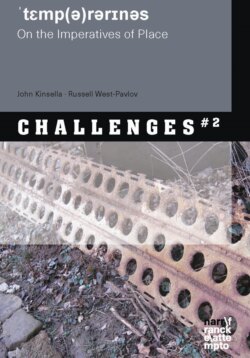Читать книгу Temporariness - John Kinsella - Страница 27
На сайте Литреса книга снята с продажи.
Journaling an Activist Poetics
ОглавлениеI have been keeping a journal since I was fifteen. Most of my early journals are long gone, but some remain from when I was nineteen and twenty. The journal was quite different from a diary, which I also kept—mainly to record what had to be done rather than what was to be done. As I became more directly ‘activist’ in my late teens, attending protest rallies against nuclear energy, against the logging of old-growth forests, and in support of indigenous land rights, elements of my thinking about the nature of protest, and where it did or didn’t segue with writing poetry, started to appear. As the years went by and activism became the major focus of my interaction with ‘public space’, and poetry increasingly became a means for me to express what inevitably led to the lock-up in the ‘outside’ world, the focus in my journals shifted to writing about how best to create an activist poetics, how to create a dialogue between the poetic act and the activist moment.
This is not to say that the journals became purely places of discussing modes of protest; rather, they are a space for the consideration of what a poem might focus on so as to extend my desire to articulate my distress at the degradation of human rights and the ‘natural’ environment. I look back over a life of writing poetry—I started as a child—and sadly find a ‘tracking’ of environmental destruction and climate change. However, this is not a case of the poems necessarily ‘saying’ something is wrong, but of it being implied in what the poem is observing. My journals, and my poetry, are often inscriptions of the world around me in any given place or time. So, I will record the presence of different birds, insects, mammals and so on. I will discuss plant types and what phase of their cycle they are in, and so on. It’s in these records that I track the truest activism I can offer: a witnessing, and a recording.
What follows is a series (albeit syncopated) of journal entries written between June and October 2016, from recent journals that utilise much the same kind of patterning as my journals have over the decades. You will hear the observations of place and a lot of conjecturing over the nature of place and space; you will get opinion on various texts I am reading, you will have the tendentious and the overtly subjective, and you’ll get information on environmental and social issues I feel strongly about, and am trying to respond to in activist ways.
But this is not merely a set of disparate journal entries. I want to say that I always write with two formal agendas—one is for each day to be contained in itself, but second, for each day to connect to the discourse of other days. In other words, the journals have their own diegesis, their own narrative arc and their own dialogics with that (or those) narrative/s. At times, the journal becomes a poem sketchbook; at others, interludes in essay-making, but all in all, they are an expression of my angst at failing to halt the destruction I see happening around me daily.
But the journal entries never give in—there is always hope of positive outcomes. It is this movement between the private space of the journal and the public space of (pacifist) action that drives the journals, that underpins my compulsion across almost forty years to keep a writing and activist journal that is consistent (basically consistent—there have been long gaps at times for all sorts of reasons).
JK
